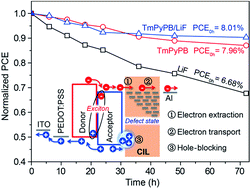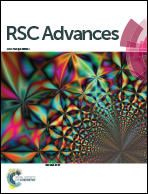Effect of organic cathode interfacial layers on efficiency and stability improvement of polymer solar cells†
Abstract
The cathode interfacial layer (CIL) plays a vital role in enhancing the efficiency and lifetime performance of bulk heterojunction (BHJ) polymer solar cells (PSCs). Here, we compared the use of various organic semiconducting molecules, tris(8-hydroxyquinolinato) aluminum (Alq3), bathocuproine (BCP) and 1,3,5-tri(m-pyrid-3-yl-phenyl)benzene (TmPyPB), as CILs in PSCs and analyzed their influence on device performance. Compared to the inorganic LiF CIL-based PSCs, significantly higher photovoltaic performance was observed by using these organic CILs in both PTB7:PC71BM and P3HT:PC61BM PSCs. Specifically, TmPyPB CIL-based devices exhibit superior device stability and high power conversion efficiency (PCE) up to 7.96%. A systematic study on the effects of Frontier orbital energy levels, surface morphology, and electron mobility of CILs suggests that a relatively coarse interface morphology would be helpful in the formation of high-density interfacial defect states for efficient electron extraction and a high mobility is of central importance in facilitating electron collection for high PCEs. Moreover, a synergistic effect between the inorganic LiF and organic molecules in the dual-CIL could contribute to the further enhancement of PSC efficiency (8.01%) and ambient stability. This work reveals fundamental principles in regulating the functions of CILs and would hopefully promote the investigation and development of ideal organic CILs for high-performance PSCs.



 Please wait while we load your content...
Please wait while we load your content...